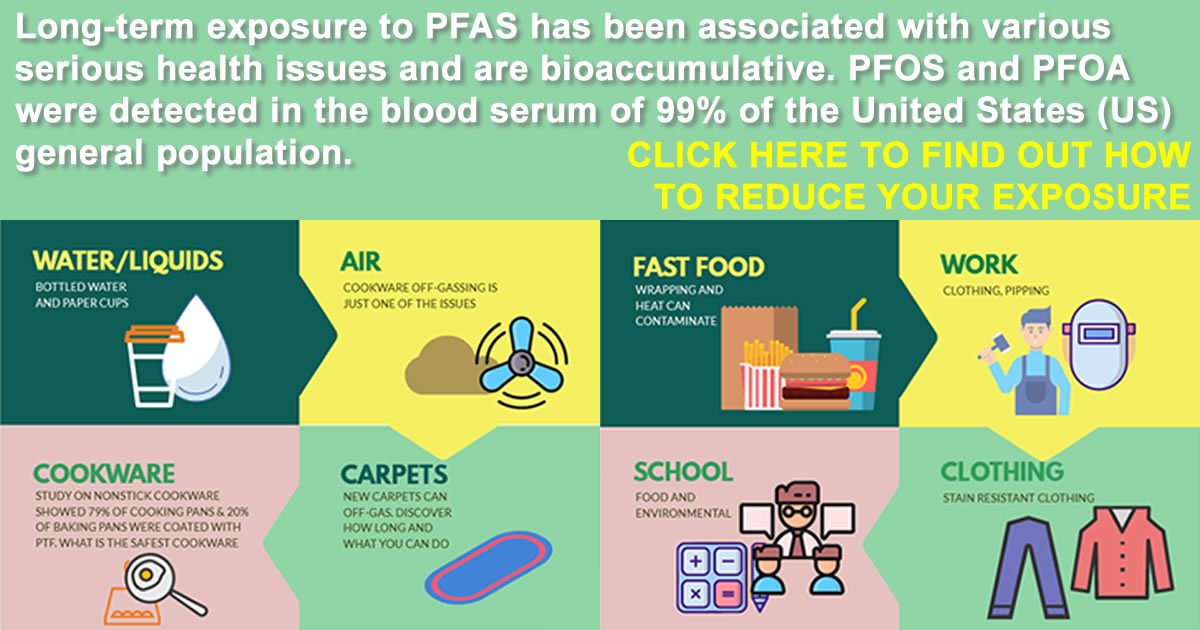Common Exposure Points of PFAS/Teflon
 Work[2]; workers in the USA, specifically Chemical manufacturing[3]–[4], firefighting[5]–[6], and ski wax technicians[7]–[8] have a higher probably to exposure to PFASs than the general public. In other words, the ‘general public” are also constantly exposed.
Work[2]; workers in the USA, specifically Chemical manufacturing[3]–[4], firefighting[5]–[6], and ski wax technicians[7]–[8] have a higher probably to exposure to PFASs than the general public. In other words, the ‘general public” are also constantly exposed.- School[9]; based on body weight, children drink and eat more than adults. Studies have shown that fluorine is detected in 65% of children’s textiles, the highest concentration in “stain-resistant” school uniforms. What was most alarming is that the researchers discovered that clothing made labeled “100% cotton” contained more PFAS than synthetic clothing[10]. Further, PFAS exposures appear to modulate immune responses in children, with the evidence being most conclusive for an immunosuppressive. Both prenatal and childhood exposures to PFASs appear to modulate immune function[11].
- Eating Out; People who eat more takeout/ fast-food have been shown to have higher levels of PFAS then people who cook at home[12]. Lets not forget school lunches. Disposable food packaging and tableware made of paper, board, and moulded plant fiber such as fast-food bags (French fries), bakery bags, and pizza boxes[13]–[14]
- Home; One study by the Ecology Center on nonstick cookware showed that despite growing regulations and concern about the toxicity of PFAS, most nonstick cooking pans and some baking pans are coated with a polymer form of PFAS called PTFE (polytetrafluoroethylene), which is typically made using several hazardous PFAS (per- and polyfluorinated alkyl substances) that have polluted drinking water across the globe.
- Clothing; “Stain-resistant” and water resistant clothing often is associated with PFAS[15].
- Nature[16]; the water and air can be contaminated, fish caught from water contaminated by PFAS and dairy products.
- Presently, you can’t escape them. To review a comprehensive list of what PFAS can be found in Click Here.
<<<<BACK
[1] EPA Comptox Dashboard (https://comptox.epa.gov/dashboard/chemical-lists/pfasmaster [accessed May 25, 2022]).
[2] https://www.ncbi.nlm.nih.gov/books/NBK584702/
[3] Heydebreck F, Tang, J, Xie Z, Ebinghaus R [2016]. Emissions of per- and polyfluoroalkyl substances in a textile manufacturing plant in China and their relevance for workers’ exposure. Environ Sci Technol, 50(19), 10386-10396. doi:10.1021/acs.est.6b03213
[4] Olsen GW, Zobel LR [2007]. Assessment of lipid, hepatic, and thyroid parameters with serum perfluorooctanoate (PFOA) concentrations in fluorochemical production workers. International Archives of Occupational & Environmental Health, 81(2), 231-246.
[5] Rotander A, Toms LM, Aylward L, Kay M, Mueller JF [2015]. Elevated levels of PFOS and PFHxS in firefighters exposed to aqueous film forming foam (AFFF). Environ Int, 82, 28-34. doi:10.1016/j.envint.2015.05.005.
[6] Leary DB, Takazawa M, Kannan K, Khalil N [2020]. Perfluoroalkyl substances and metabolic syndrome in firefighters: A pilot study. J Occup Environ Med, 62(1), 52-57. doi:10.1097/JOM.0000000000001756.
[7] Freberg BI, Haug LS, Olsen R, Daae HL, Hersson M, Thomsen C, . . . Ellingsen DG [2010]. Occupational exposure to airborne perfluorinated compounds during professional ski waxing. Environ Sci Technol, 44(19), 7723-7728. doi:10.1021/es102033k
[8] Nilsson H, Karrman A, Rotander A, van Bavel B, Lindstrom G, Westberg H [2013]. Professional ski waxers’ exposure to PFAS and aerosol concentrations in gas phase and different particle size fractions. Environ Sci Process Impacts, 15(4), 814-822. doi:10.1039/c3em30739e
[9] https://www.indianaenvironmentalreporter.org/posts/children-being-exposed-to-pfas-chemicals-through-stain-resistant-and-waterproof-school-uniforms
[10] Chunjie Xia, Miriam L. Diamond, Graham F. Peaslee, Hui Peng, Arlene Blum, Zhanyun Wang, Anna Shalin, Heather D. Whitehead, Megan Green, Heather Schwartz-Narbonne, Diwen Yang, and Marta Venier, Per- and Polyfluoroalkyl Substances in North American School Uniforms, Environmental Science & Technology 2022 56 (19), 13845-13857 DOI: 10.1021/acs.est.2c02111
[11] Liew Z, Goudarzi H, Oulhote Y. Developmental Exposures to Perfluoroalkyl Substances (PFASs): An Update of Associated Health Outcomes. Curr Environ Health Rep. 2018 Mar;5(1):1-19. doi: 10.1007/s40572-018-0173-4. PMID: 29556975; PMCID: PMC6348874
[12] https://www.ehn.org/pfas-in-food-packaging-2640885250.html
[13] https://dec.ny.gov/environmental-protection/recycling-composting/businesses/pfas-in-food-packaging
[14] https://www.ehn.org/fast-food-pfas-2665713188.html
[15] Chunjie Xia, Miriam L. Diamond, Graham F. Peaslee, Hui Peng, Arlene Blum, Zhanyun Wang, Anna Shalin, Heather D. Whitehead, Megan Green, Heather Schwartz-Narbonne, Diwen Yang, and Marta Venier, Per- and Polyfluoroalkyl Substances in North American School Uniforms, Environmental Science & Technology 2022 56 (19), 13845-13857 DOI: 10.1021/acs.est.2c02111
[16] https://www.cdc.gov/biomonitoring/PFAS_FactSheet.html

